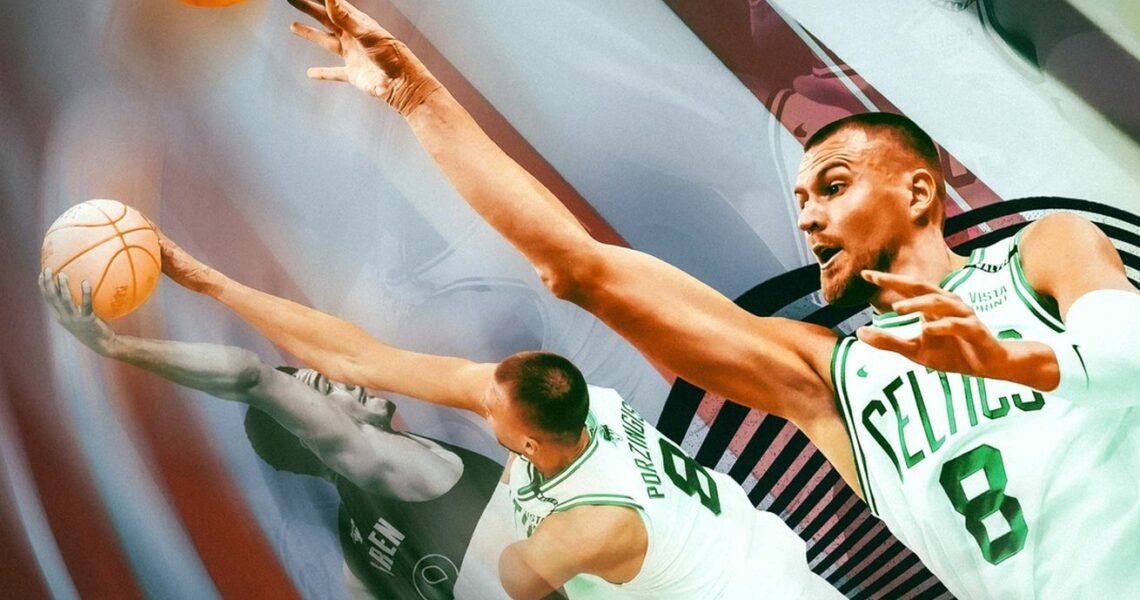
The Boston Celtics are a different beast when their matchup-busting center is spacing the floor and protecting the rim. Can Dallas find any answers to its Porzingis problem?
There comes a point in many Boston Celtics games when the very source of their dominance tilts off-balance. When the barrage of 3s that built their lead suddenly turns up empty. When the hunt for the best possible shot, and all the well-intentioned ball movement behind it, can start to feel aimless. In those moments, Boston can feel oddly vulnerable for a powerhouse team—surrendering leads in a way that puts otherwise lopsided games up for grabs. So it should come as no surprise that the Celtics built a 29-point lead in Game 1 of the NBA Finals, only to let the bulk of it slip away.
“I think our offense got a little stagnant, and it had a lot to do with our spacing,” Jayson Tatum said. “They kind of put us into some bad ways on offense, which kind of threw off our spacing and slowed us down.” Even a series ago, that familiar script might have ended with Boston in a crunch-time rock fight. Clearly, the Celtics are capable of gutting out those games, but the most important development on Thursday night was that they didn’t have to. You could feel the balance of the Celtics shifting under them, with more options on offense and more formidable rotations on defense. Boston finally felt complete—and it rallied and responded so decisively after losing its initial lead that Dallas pulled its starters with more than five minutes remaining, ending the opening bout of the Finals in a 107-89 surrender.
The difference in the Celtics—between who they were on Thursday night and who they’ve been for most of these playoffs—was Kristaps Porzingis. Boston’s matchup-busting center returned to game action for the first time since straining his calf against the Heat 38 days ago, coming in off the bench to wreck every defensive switch. The 6-foot-3 Jaden Hardy had no chance. Josh Green was dead in the water. Even the bigger, stronger Luka Doncic, who knows Porzingis’s game all too well, sometimes looked absolutely helpless in trying to slow his former teammate. “He’s a matchup nightmare,” Derrick White said. “Even when you play good defense, he doesn’t really see you.” And by the end of the night, that persistent waking nightmare had yielded 20 points in 21 minutes, as well as steady rebounding and hellacious rim protection.
“At the end, it’s just basketball, and I’ve been doing this for a long time,” Porzingis said. “Even if I have time off, I can jump right back in, and I feel the same way. I can get to my spots, and I do. So whether it’s playoffs, regular season, or whatever, I know how to do this.”
That kind of production was problem enough for the Mavericks, who sputtered to their lowest scoring total of the postseason on Thursday night. Yet for Porzingis, in particular, to look this comfortable this quickly poses real structural issues for the Dallas defense. Porzingis was the single most efficient post scorer in the NBA this season, according to Synergy Sports, precisely because he destroyed these sorts of mismatches. If his recently injured calf won’t slow him down at all, switching against the pick-and-roll might not be a viable strategy for the Mavs in this series—which in itself would lead to a cascading series of other problems rooted in other potential styles of coverage. Boston very much wants you to scramble, bringing extra defenders to the ball or into the paint so that Tatum and Jaylen Brown can swing the ball out to shooters for the punishing blow.
Switching against the ball screen, if nothing else, is a means of containment: an attempt to keep everything in its place, with a defender in front of every opponent. Porzingis breaks the formula by making the defender in front of him largely irrelevant. He took 13 attempts from the floor in Game 1, making eight. Porzingis might shoot less often in Game 2, but only because he will have forced the Mavericks’ hand to make some kind of address. It can be challenging to stick to a switching scheme for just this reason. What do you do when a 7-foot-2 center is making shots from the elbow look like layups? It might even be the smart tactical play to force Porzingis to beat the switch again in Game 2—to prove that he can be as physical in fighting for his spot on that injured calf, and as consistent in converting some of his tougher looks. But if he succeeds, Dallas could be on the ropes before this series has even really begun.
Yet if the Mavericks do change up some of their core defensive mechanics, Porzingis can create similar problems by running a pick-and-pop with any of Boston’s many ball handlers, or even just by spacing the floor—and pulling away a big—from the weak side. “Having him back and him playing well and to that level he was during the season is so important for us because you got another defender, another shooter, out there that you have to respect,” Brown said. “So that just opens it up for everybody else.” And because of that, Porzingis is an existential threat to Daniel Gafford and Dereck Lively II in this series. If the Mavs match up one of their rim-protecting centers against Porzingis, by default, they undercut what they do best by stranding them out in space, far away from the basket. Yet if the Mavs don’t match up one of their bigs against Porzingis, they present on a platter the exact sort of mismatch the Celtics would otherwise work to create.
This is how Boston breaks you. “We’re a good team when guys are down, but we’re really, really special when we have everybody,” Tatum said. A good team can somewhat messily take care of business against the Pacers; a special one can completely dismantle the Mavericks. Porzingis is Boston’s margin for error. What’s a third-quarter lull against an opponent that’s compromised down to their very scheme? There’s so much more room for Boston to ebb and flow when Porzingis challenges Dallas at the core of its identity.

